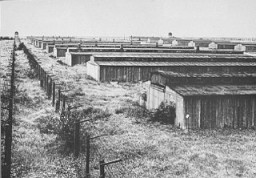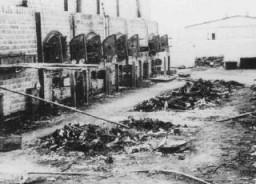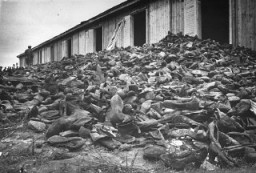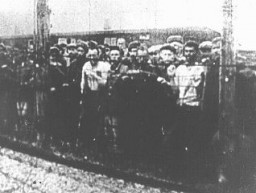
Lublin/Majdanek Concentration Camp: Administration
Between 1933 and 1945, Nazi Germany and its allies established more than 44,000 camps and other incarceration sites (including ghettos). The perpetrators used these locations for a range of purposes, including forced labor, detention of people deemed to be "enemies of the state," and mass murder. Millions of people suffered and died or were killed. Among these sites was Majdanek.
The Lublin concentration camp received its more widely known nickname “Majdanek” (“Little Majdan”) due to its proximity to the Majdan Tatarski suburb of Lublin, the capital of the Lublin District in the so-called Generalgouvernement (that part of German-occupied Poland not directly annexed to Germany, attached to German East Prussia or incorporated into the German-occupied Soviet Union). The camp was located three miles east southeast of Lublin on the road that led to Chelm.
On a visit to Lublin on July 20-21, 1941, four weeks after the invasion of the Soviet Union, SS chief Heinrich Himmler ordered the SS and Police Leader for District Lublin, SS Major General Odilo Globocnik, to establish a large concentration camp in Lublin with the capacity to hold up to 50,000 prisoners.
The purpose of the camp was to provide forced laborers to work on construction projects for proposed SS and police bases throughout eastern Poland and the occupied Soviet Union. These facilities were intended to be militarized and industrialized agricultural complexes around which permanent German settlements in eastern Europe would grow and expand, after the Germans physically annihilated Jews and members of the Polish and Soviet leadership elites. Prisoners at Majdanek were to provide labor for the establishment of the initial SS and police base in Lublin. Since Polish workers, due to forced deportations to the Reich to meet labor needs there, had already become scarce, Himmler and Globocnik planned to incarcerate Jewish forced laborers in Majdanek.
From October 1941 until February 16, 1943, Majdanek had the official designation “Prisoner of War Camp of the Waffen SS in Lublin.” This appellation permitted the SS to tap into state funding streams without civilian or military oversight. Despite this administrative subterfuge, the camp administration and the guard detachment at Majdanek were, as was the case for other German concentration camps such as Buchenwald, Dachau, and Mauthausen, subordinated to the Inspectorate of Concentration Camps in Berlin. On February 16, 1943, in reflection of the administrative realities, the SS renamed Majdanek “Concentration Camp Lublin.” Nevertheless, Majdanek was unique among concentration camps in that Globocnik, as regional SS and police leader, exercised unusually close control over the operations of the camp—particularly within the framework of Operation Reinhard, until his departure from Lublin in September 1943.
“Operation Reinhard,” implemented under Globocnik’s supervision between October 1941 and November 1943, had four goals:
- the physical annihilation of the Jews residing in the Generalgouvernement
- the exploitation of some Jews selected to survive temporarily as forced laborers
- the seizure, evaluation, and recycling of clothing, personal property, valuables, and currency taken from the murdered Jews at the killing centers
- the identification of allegedly hidden assets of the Jews in the Generalgouvernement
Within the framework of Operation Reinhard, Majdanek primarily served to concentrate Jews whom the Germans spared temporarily for forced labor. It occasionally functioned as a killing site to murder victims who could not be killed at the Operation Reinhard killing centers: Belzec, Sobibor, and Treblinka II. It also contained a storage depot for property and valuables taken from the Jewish victims at the killing centers.
Like other concentration camps in the Reich, Majdanek also served as a killing site for targeted groups of individuals, including members of the Polish resistance, hostages taken from the Security Police prison in Lublin, and prisoners in the camp itself who were deemed no longer capable of work.
From October 1941 until August 1942, Majdanek was commanded by SS Colonel Karl Koch. After Koch’s arrest for corruption, SS Major Max Koegel was commandant until November 1942, when he was replaced by Lieutenant Colonel Hermann Florstedt, who himself was arrested on suspicion of corruption in late October 1943. SS Lieutenant Colonel Martin Weiss commanded Majdanek from November 1, 1943, until May 5, 1944. SS Lieutenant Colonel Arthur Liebehenschel then oversaw the camp until the Germans abandoned it in late July.
Though originally planned for the incarceration of 50,000 prisoners, it never held that many concentration camp prisoners at one time. Majdanek was eventually divided into six compounds. In the fall of 1943, Compound I was a women's camp; Compound II was a field hospital for Russian collaborators attached to the German army; Compound III was a men's camp for Polish political prisoners, as well as Jews from Warsaw and Bialystok; Compound IV was a camp for men, mainly Soviet prisoners of war, civilian hostages, and political prisoners; Compound V served as a men's hospital camp; and Compound VI, a largely undeveloped compound, was intended for additional barracks, crematoria, gas chambers, and factories. The Germans did not complete construction of this last compound before the camp was liberated.
Critical Thinking Questions
- Where were camps located?
- To what degree was the local population aware of this camp, its purpose, and the conditions within? How would you begin to research this question?
- What choices do countries have to prevent, mediate, or end the mistreatment of imprisoned civilians in other nations?



